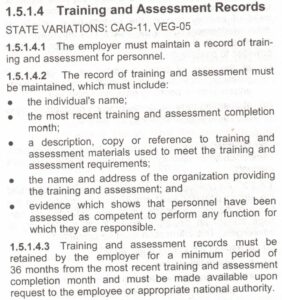Before we begin…
The Pipeline and Hazardous Materials Safety Administration within the U.S. Department of Transportation (USDOT/PHMSA) creates and enforces the Hazardous Materials Regulations (HMR) for the transportation of hazardous materials (HazMat) to, from, or through the U.S.
The Dangerous Goods Regulations of the International Air Transport Association (IATA) are produced in consultation with the International Civil Aviation Organization (ICAO) and are the guide recognized by the world’s commercial airlines for the transportation of dangerous goods by air.
The content of this Q&A is based on the 63rd Edition of the IATA Dangerous Goods Regulations, effective January 01, 2022 until December 31, 2022.
The question:
Subject: IATA certification requirements
Message Body:
I have an on-line shipping training for researchers at my institution on shipping biologicals and dry ice. A test is given and upon passing and they get a certificate with my name and the date on it along with a description of the course: Shipping Dangerous Goods training and Class 6.2 Infectious substances and Class 9 Miscellaneous Goods.
Our parent organization wants to have one training for many institutions within the system. Currently the biosafety officers at institutions with biosafety programs have their own programs/tests for this certification. And we are available for consult with any questions. I am not sure that the smaller hospitals that have some shipping needs should be certified by myself or one corporate trainer. I don’t even know where these institutions are located.
The question is, what are the requirements for the actual certificate, (does the trainer’s name need to be on this?) and does each entity/hospital within the larger corporation need to have a trained trainer on site to cover the needs of these hospitals? Is each individual institution liable for their own shippers?
Thank you for your insight.
The answer:
Thank you for contacting me. Please see below.
- IATA does not require a certificate for trainees. I provide a certificate with my training because people expect it.
- IATA Dangerous Goods Regulations at H.A.1.5.5 (Appendix H) require the following record of training (initial and biennial):
- Individual’s name.
- Most recent training completion month.
- Description, copy, or reference to training materials used.
- Name and address of organization providing training. Not the name of the trainer, though I put mine on it.
- Evidence which shows test completed satisfactorily.
- 1.5.1.4 reads differently than the above as the regulations now require an assessment of competence instead of just a test. However, the new – and more stringent – requirements (those found in 1.5.1.4) do not become mandatory until 01.01.23.
- I provide a record of the training separate from the certificate.
- Each site does not have to have its own trainer. I provide training for multiple businesses.
- Each employer is required to ensure its personnel receive the required training.
I hope this helps. Please contact me with any other questions.
A concern:
Thank you. My concern is if there were an incident, we have our training online, and only admins would have access to the exam results which would need to be presented. What is the liability for the “owner” of the training? When there are incidents, who provides the corrective action letter? I’ve done this for my institution.
I appreciate your advice.
My reply:
Good questions. Legitimate concerns. Please see below.
- Any training – at least mine – will provide you with the required documents to record the training. This may include documents to print or save as pdf.
- There is no liability for the owner of the training (if by that you mean the training provider). Regulations of IATA & USDOT/PHMSA put the responsibility for ensuring the adequacy of training and testing on the employer.
- Not quite sure what you mean by “incidents”. If you mean an inspection by regulatory agency, then employer must make records of training available for inspection.
- If applicable, corrective action letter would be written by the company faced with the non-compliance. Likely the employer. However corrective action letter won’t be necessary if training and testing adequate and records available for inspection.
- IATA training requirements will become more strict as of 01.01.23.
Please contact me with any other questions.
|
Contact me with any questions you may have about the transportation of hazardous materials by air, highway, vessel, or rail International and Domestic |
Any more questions:
The contact actually had another question, but it was related to the Materials of Trade exception and not the training requirements of IATA. The content of that email exchange will be handled in a separate Q&A.


